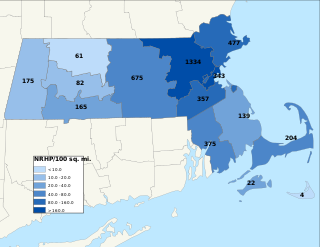
The National Register of Historic Places is a United States federal official list of places and sites considered worthy of preservation. In the state of Massachusetts, there are over 4,300 listings, representing about 5% of all NRHP listings nationwide and the second-most of any U.S. state, behind only New York. Listings appear in all 14 Massachusetts counties.

The Theodore Baird Residence, also known as Baird House, is a suburban house designed by American architect Frank Lloyd Wright, and located at 38 Shays Street in Amherst, Massachusetts, United States. It is the only Wright design in Massachusetts.

Alewife Brook Parkway is a short parkway in Cambridge and Somerville, Massachusetts. It is listed on the National Register of Historic Places. It begins at Fresh Pond in Cambridge, and heads north on the east bank of Alewife Brook, crossing into West Somerville and ending at the Mystic River on the Medford town line, where it becomes Mystic Valley Parkway. The entire length of Alewife Brook Parkway is designated as part of Massachusetts Route 16 (Route 16), while the southernmost sections are also designated as part of Route 2 and U.S. Route 3 (US 3). It is managed by the Department of Conservation and Recreation with the Massachusetts Department of Transportation responsible for bridge maintenance.

This is a list of sites listed on the National Register of Historic Places in Cambridge, Massachusetts. This is intended to be a complete list of the properties and districts on the National Register of Historic Places in Cambridge, Massachusetts, United States. Latitude and longitude coordinates are provided for many National Register properties and districts; these locations may be seen together in an online map.

The Cambridge Common Historic District is a historic district encompassing one of the oldest parts of Cambridge, Massachusetts. It is centered on the Cambridge Common, which was a center of civic activity in Cambridge after its founding in 1631. It was the site of the election for governor of the Massachusetts Bay Colony in 1636, and was a military barracks site during the American Revolutionary War. The common was gradually reduced in size to its present roughly triangular shape, and surrounded by buildings in the 18th and 19th centuries. In 1973 a historic district encompassing the extant common and everything within 100 feet (30 m) of it was listed on the National Register of Historic Places. In 1987 the district was amended to rationalize the boundary, which overlapped adjacent districts and included portions of some buildings.
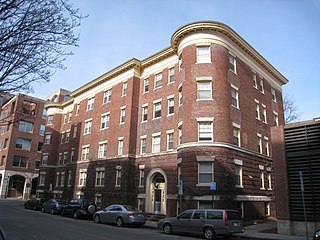
Craigie Arms is a historic apartment house in Cambridge, Massachusetts. Located in Harvard Square, the Georgian Revival four-story brick building was built in 1897 to meet local demand for apartment-style housing. The building occupies most of a city block along University Road, Mount Auburn Street, and Bennett Street. It is notable for its relatively modest decoration and the rounded corner projections.

The Richard Hapgood House is an historic multiunit house at 382-392 Harvard Street in Cambridge, Massachusetts. The six-unit wood-frame building was built in 1889, and represents an unusual instance of Queen Anne styling applied to such a large structure. It was built at a time when housing stock was transitioning from small types of multiunit housing to larger formats such as tenements and apartment houses.

The Jarvis is a historic apartment building at 27 Everett Street, on the north side of the Harvard University campus in Cambridge, Massachusetts. Built in 1890, the 4+1⁄2-story brick building was one of the first apartment houses built in the vicinity of northern Massachusetts Avenue. At the time, Massachusetts Avenue north of Harvard was predominantly lined with large fashionable houses. The Jarvis fit into this to some extent by being designed to resemble a large single family residence of the time. The building has irregular Queen Anne massing, polychrome trim, and massive corbelled end chimneys.

The Lechmere Point Corporation Houses is a historic apartment rowhouse at 45–51 Gore St. and 25 3rd Street in Cambridge, Massachusetts. Built sometime before 1821, this 2+1⁄2-story brick-and-wood structure is the only surviving building to be built by the Lechmere Point Corporation, which developed East Cambridge in the early decades of the 19th century. The house was owned for a time by lawyer and politician Christopher Gore, a principal of the corporation who also speculated in area real estate. Two of the buildings have retained their original gable roofs, while 49 Gore Street has been raised to a full three stories and given arched windows, and 51 Gore Street has had a mansard roof added.

The Memorial Drive Apartments Historic District is a historic district encompassing four apartment houses on Memorial Drive in Cambridge, Massachusetts. They are located between the Anderson Memorial Bridge and the Eliot Bridge with street numbers ranging from 983 to 993 Memorial Drive. All four buildings were built between 1916 and 1924, not long after Memorial Drive had been laid out, and were, despite significant similarities of style, designed by three different architects. All provide good views of the Charles River. The district was listed on the National Register of Historic Places in 1986.

The Lowell is an historic triple decker apartment house on 33 Lexington Avenue in Cambridge, Massachusetts. Built in 1900 to a design by local architect John Hasty, it is a rare multiunit building in the Brattle Street area outside Harvard Square. The Colonial Revival building has a swan's neck pediment above the center entry, which is echoed above the central second story windows. Doric pilasters separate the bays of the front facade, and the building distinctively has side porches, giving it added horizontal massing. It was built before the decision was made to locate the electrified trolleys on Mount Auburn Street instead of Brattle, a decision that reduced interest in building more multiunit housing in that area.
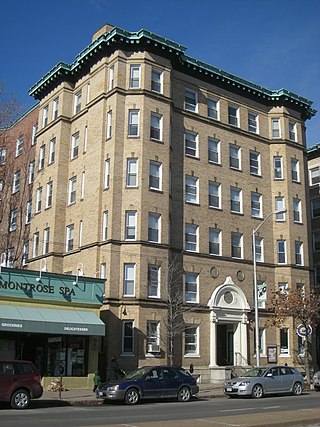
The Montrose is a historic multiunit residential building in Cambridge, Massachusetts. It is a six-story yellow brick building, whose Italian Renaissance details include a copper cornice with modillions, varied window treatments on each floor, belt courses of brickwork between some of the floors, and a front entry surround with fluted Doric columns. Built in 1898, it was one of the first "French flat" luxury apartment houses built in the city. The building was listed on the National Register of Historic Places in 1986.

The Norfolk Street Historic District is a historic district at Norfolk Street between Suffolk and Bishop Allen Streets in Cambridge, Massachusetts. It encompasses two distinct phases of 19th century residential development in the city: a period in the 1840s when a series of Greek Revival cottages was built, and the 1880s, when four-story "hotel" construction predominated. Many of the Greek Revival cottages have been altered, although that at 73 Norfolk is particularly well preserved. The district features works by James Fogerty and other local architects.

Ware Hall is an historic residential apartment building at 383 Harvard Street in Cambridge, Massachusetts. It was designed by local architect George Fogerty and built in 1893. Fogerty was also the architect of Claverly Hall, a similar building, on Mount Auburn Street. This five story brick Classical Revival building is a rare example of an apartment house built in Mid Cambridge that was designed to cater to Harvard University students. Apartment blocks of this quality were generally built closer to the Harvard campus, so this one stands out when compared to other apartment house in its immediate surroundings.
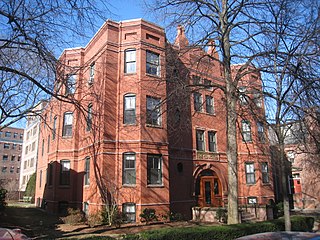
The Stanstead is a historic apartment building located at 19 Ware Street in Cambridge, Massachusetts. The three-story Richardsonian Romanesque building was built in 1887, and is an uncommon brick rendition of a triple=decker, more typically a wood-frame construction, that was just becoming popular in Cambridge. The architects, J. R. & W. P. Richards, also designed The Jarvis, another early brick apartment house in the city.
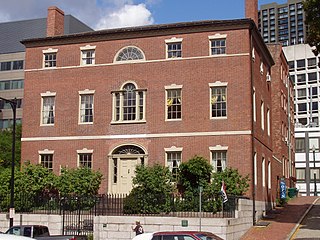
The First Harrison Gray Otis House is a historic house museum and National Historic Landmark at 141 Cambridge Street in the West End of Boston, Massachusetts. The house, built in 1795–96, was the first of three houses designed by Charles Bulfinch and built for Massachusetts politician Harrison Gray Otis. It is notable as one of the earliest three-story brick houses that came to represent the Federal style of architecture, and its interiors show the influence of Robert Adam. The house is now the headquarters of Historic New England, a regional preservation organization, and is open year-round for tours.
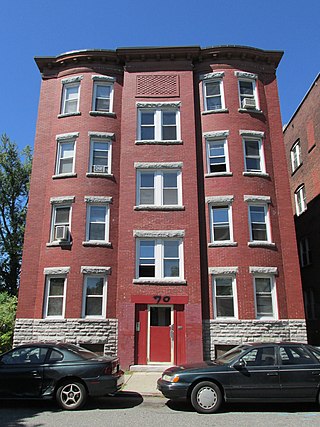
The Ethel Apartment House is a historic apartment building at 70 Patton Street in the North End of Springfield, Massachusetts. The four story red brick building was built in 1912 for Jacob Blisky, a successful local retailer, at a cost of $14,000. It was designed by Burton E. Geckler, a local architect who designed a number of other apartment blocks during the 1910s. The building was listed on the National Register of Historic Places in 1987.

The buildings at 35–37 Richardson Avenue are historic rowhouses in Wakefield, Massachusetts. These two rowhouses, built c. 1912–15, are among the earliest apartment blocks built in the town. They were built by Solon O. Richardson, Jr. on a portion of his estate. The buildings were listed on the National Register of Historic Places in 1989.

The Ivernia Apartment Building is a historic residential apartment building at 91-93 Pine Street on the east side of Springfield, Massachusetts. Built in 1910, it is a well-preserved example of a Classical Revival apartment house, built during a boom period of apartment construction in the city. The building was listed on the National Register of Historic Places in 2015.
Flentje is a surname. Notable people with the surname include:






















